NAMT Team Robot Car at Robocross 2012
Hello. My name is Vladimir and I want to talk a little about the robot car of the team from Nizhny Novgorod NAMT, who won the 3rd All-Russian Robot Robot Competition 2012 Robocross-2012 in Volokolamsk. A team report from Saratov MobRob has already been published here , now I want to talk about our ordeals.
The competition was as follows: it was necessary to automatically or remotely drive from the starting point across the field, enter the gate and transmit the image of the three control points to the operator, and then drive into the finish gate and stop there. GPS / GLONASS coordinates of the gates and control points were previously known to the teams. Points were awarded for the speed of the route (but the rules of the competition prohibited the speed of more than 10 km / h) and the transmitted images of control points.
It so happened that we almost missed these competitions - the National Instruments Single-Board RIO controller provided by the organizers burned down, while we agreed on the purchase of a new NI cRIO-9075, until it arrived, the competition started. As a result, many ideas had to be abandoned. For example, they did not manage to set up the autopilot algorithm for following the route; I had to use the simplest direct guidance to control points. There was also no talk of recognizing obstacles.
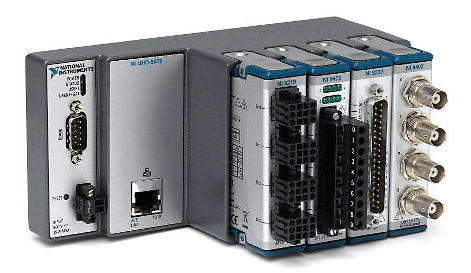
The autopilot is built on the National Instruments cRIO-9075 controller and a laptop with SSD for working with USB cameras.
The controller receives a signal from the potentiometric wheel position sensor, a signal from the engine speed sensor and, via RS-232, information from the GPS / GLONASS receiver. The control goes to the servo connected to the input of the power steering instead of the steering column and the engine start / stop system.
Since the competition regulations limit the maximum vehicle speed to ten km / h, there was no need for a gear shift system, the car starts in first gear by starting the engine and stops when it is turned off.
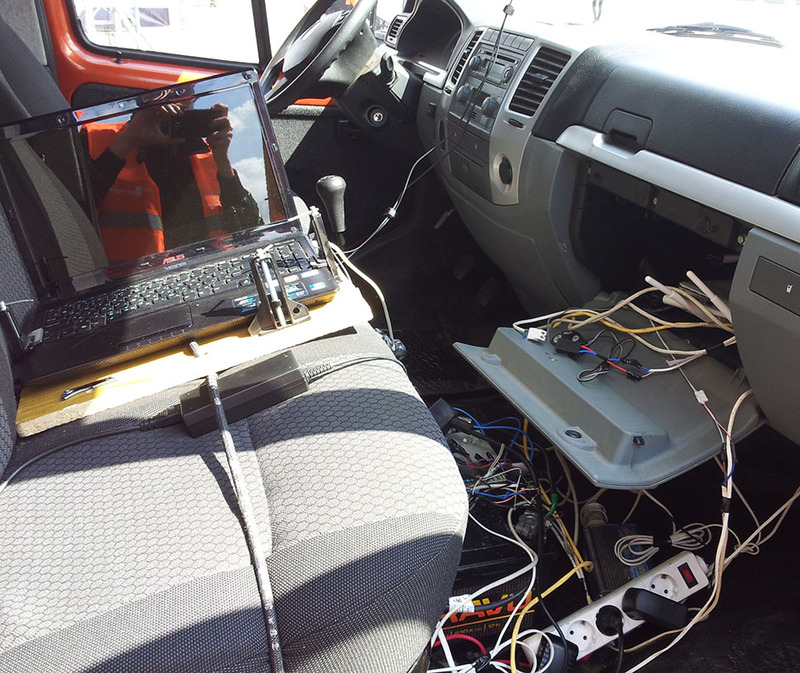
Two USB cameras are connected to a laptop with SSD (our roads are not sugar), providing a view from the cab.

All this economy via the ASUS RT-N16 router is connected to a single-watt Wi-Fi access point Bullet fixed in the back with an omnidirectional antenna configured in bridge mode with an access point connected to the operator’s workstation of our “drone”.
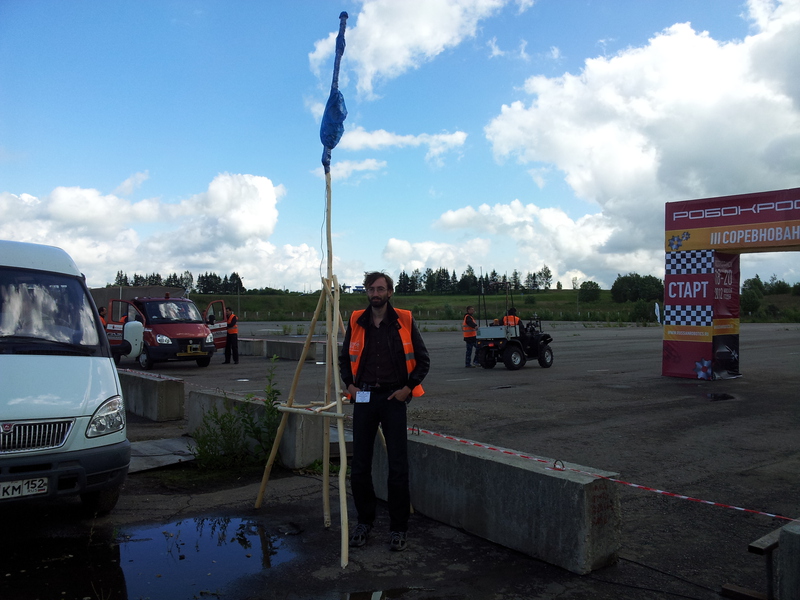
The software filling of the car is divided into two independent parts - driving and collecting and transmitting video. Everything is written in the visual programming language LabVIEW.
Due to the technical problems described above, the management is extremely simplified, but operational.
A steering wheel control loop and a GPS / GLONASS navigation loop have been implemented. A direct pointing algorithm with a small proportionality coefficient is used. The satellite coordinates of the car, direction and speed are taken from the satellites, the error of direction to the next point of the route is calculated from them, and the required position of the car wheels is generated. To prevent the servo drive from failing, a check of the engine operation was added (without it the power steering does not work, you can try to turn the wheels before smoke).
The laptop collects the picture from the USB cameras, converts it into one frame and, having pressed it, sends it to the operator.
In addition to the automatic mode, the remote control mode is also implemented, it turned out something similar to the game "Truckers".
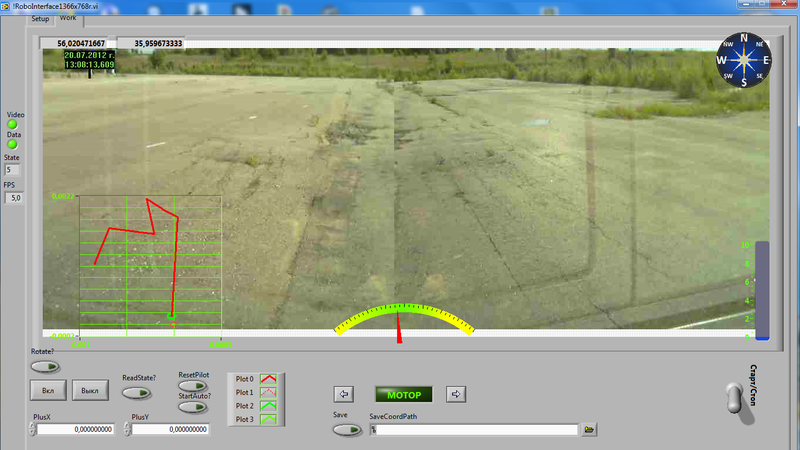
In the process of preparation, time and weather were running out for us (on the first day allotted for assembly, there was a shower, then the weather changed very sharply, from hot sun to rainy dampness). As a result (as it turned out later), the wheel position sensor was incorrectly calibrated and the car took a little to the left, which affected the navigation accuracy poorly. Nevertheless, the entire electronic-mechanical economy worked.
Mostly the sun was shining on the day of arrival, but the wind blew in earnest. Several correspondents and even guests appeared.
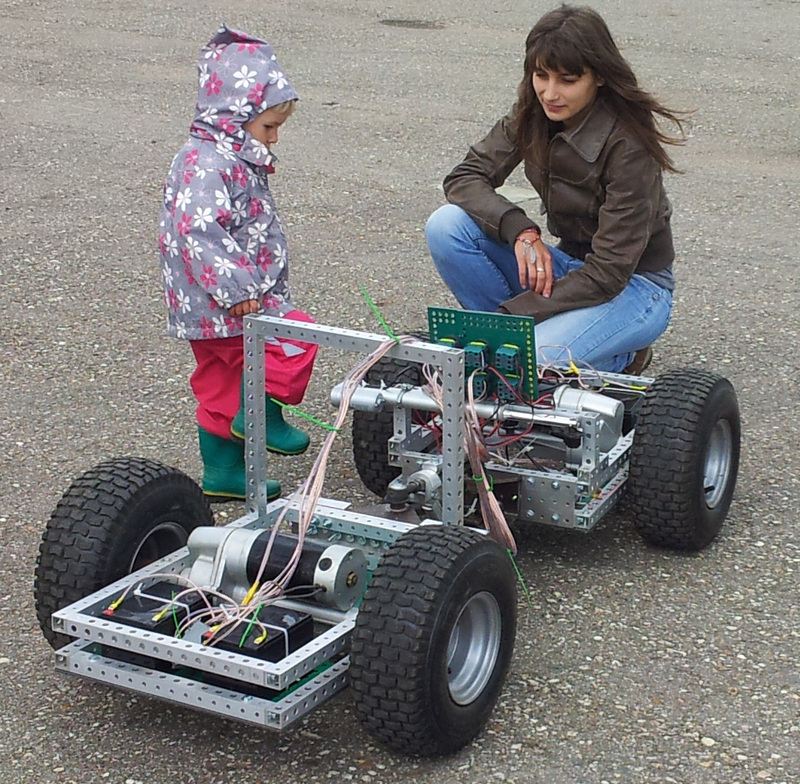
The race itself was expected: the navigation algorithm lost time, aiming at each waypoint, but it worked, the image was transmitted correctly and in the required quality, the finish slowly approached as the control points passed. And approached.
The runner-up MobRob team implemented a better navigation algorithm, they won in time, but the failure did not allow the image of one of the control points to be transmitted.
Despite the maximum, even extreme simplicity, the system showed itself well in operation both in automatic mode and in remote control mode. The connection was stable, so the resulting little car can really be used for reconnaissance on not too rough open terrain.
But seriously, this is a good practical task, allowing you to test yourself in difficult conditions. Not everything turned out as planned, but it leaves room for growth.
The plans for the future are to develop a system for avoiding obstacles according to data from cameras or (but this is already a dream) to get a lidar. Well, of course, run around the same algorithm for following along the trajectory.
The most enchanting result was summed up by nature, with a gust of wind that knocked down the starting gate immediately after the finish of the extreme team. Fortunately, nobody was already there.
Many thanks to the teams that took part in the competition, because, despite the bad weather, various malfunctions with iron, lack of sleep and emergency, everyone came to the races! As well as GAZ and everyone who has done something good for these competitions.
About the rules
The competition was as follows: it was necessary to automatically or remotely drive from the starting point across the field, enter the gate and transmit the image of the three control points to the operator, and then drive into the finish gate and stop there. GPS / GLONASS coordinates of the gates and control points were previously known to the teams. Points were awarded for the speed of the route (but the rules of the competition prohibited the speed of more than 10 km / h) and the transmitted images of control points.
Oh sad
It so happened that we almost missed these competitions - the National Instruments Single-Board RIO controller provided by the organizers burned down, while we agreed on the purchase of a new NI cRIO-9075, until it arrived, the competition started. As a result, many ideas had to be abandoned. For example, they did not manage to set up the autopilot algorithm for following the route; I had to use the simplest direct guidance to control points. There was also no talk of recognizing obstacles.

- NI cRIO-9075 controller
About iron
The autopilot is built on the National Instruments cRIO-9075 controller and a laptop with SSD for working with USB cameras.
The controller receives a signal from the potentiometric wheel position sensor, a signal from the engine speed sensor and, via RS-232, information from the GPS / GLONASS receiver. The control goes to the servo connected to the input of the power steering instead of the steering column and the engine start / stop system.
Since the competition regulations limit the maximum vehicle speed to ten km / h, there was no need for a gear shift system, the car starts in first gear by starting the engine and stops when it is turned off.

- Robotics is easy!
Two USB cameras are connected to a laptop with SSD (our roads are not sugar), providing a view from the cab.

- Eyes - a mirror of the soul
All this economy via the ASUS RT-N16 router is connected to a single-watt Wi-Fi access point Bullet fixed in the back with an omnidirectional antenna configured in bridge mode with an access point connected to the operator’s workstation of our “drone”.

- Reliable communication is our everything!
About software
The software filling of the car is divided into two independent parts - driving and collecting and transmitting video. Everything is written in the visual programming language LabVIEW.
Due to the technical problems described above, the management is extremely simplified, but operational.
A steering wheel control loop and a GPS / GLONASS navigation loop have been implemented. A direct pointing algorithm with a small proportionality coefficient is used. The satellite coordinates of the car, direction and speed are taken from the satellites, the error of direction to the next point of the route is calculated from them, and the required position of the car wheels is generated. To prevent the servo drive from failing, a check of the engine operation was added (without it the power steering does not work, you can try to turn the wheels before smoke).
The laptop collects the picture from the USB cameras, converts it into one frame and, having pressed it, sends it to the operator.
In addition to the automatic mode, the remote control mode is also implemented, it turned out something similar to the game "Truckers".

- Who did not dream of a small radio-controlled machine?
About competitions
In the process of preparation, time and weather were running out for us (on the first day allotted for assembly, there was a shower, then the weather changed very sharply, from hot sun to rainy dampness). As a result (as it turned out later), the wheel position sensor was incorrectly calibrated and the car took a little to the left, which affected the navigation accuracy poorly. Nevertheless, the entire electronic-mechanical economy worked.
Mostly the sun was shining on the day of arrival, but the wind blew in earnest. Several correspondents and even guests appeared.

- Shift is growing
The race itself was expected: the navigation algorithm lost time, aiming at each waypoint, but it worked, the image was transmitted correctly and in the required quality, the finish slowly approached as the control points passed. And approached.
- Autopilot in action
The runner-up MobRob team implemented a better navigation algorithm, they won in time, but the failure did not allow the image of one of the control points to be transmitted.
Summary
Despite the maximum, even extreme simplicity, the system showed itself well in operation both in automatic mode and in remote control mode. The connection was stable, so the resulting little car can really be used for reconnaissance on not too rough open terrain.
But seriously, this is a good practical task, allowing you to test yourself in difficult conditions. Not everything turned out as planned, but it leaves room for growth.
The plans for the future are to develop a system for avoiding obstacles according to data from cameras or (but this is already a dream) to get a lidar. Well, of course, run around the same algorithm for following along the trajectory.
The most enchanting result was summed up by nature, with a gust of wind that knocked down the starting gate immediately after the finish of the extreme team. Fortunately, nobody was already there.
Many thanks to the teams that took part in the competition, because, despite the bad weather, various malfunctions with iron, lack of sleep and emergency, everyone came to the races! As well as GAZ and everyone who has done something good for these competitions.
